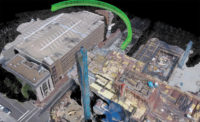With Bentley's IPO bringing it into the sphere of publicly traded companies, the software maker plans to continue its expansion into the construction phase of projects. But that doesn’t mean the company has strayed from its vision, says Keith Bentley, CTO.
“We are still engineers who love thinking about the problems engineers face, but now we can combine those efforts with all the new technology that is available,” says Bentley.
The company’s recently announced strategic partnership with Microsoft to better integrate Bentley’s cloud-based digital twins into the tech giant’s Azure cloud platform is part of that, he adds. “Microsoft does not aspire, I don’t think, to come in and be the makers of engineers' design tools, or get into that level of data management.” Instead he’s sees the partnership as a springboard to further Bentley’s efforts.
Until now much of the work in building a project's digital twin has involved the laborious work of harvesting data from design documents and other sources later in the project. But a general shift to cloud computing in the industry may change that, Bentley says. “That’s where the industry is going to head—the digital twin will be the native form factor for projects. We’ll be connected to the cloud service during the entire design process, rather than working today in a desktop environment and converting the data multiple times (to create a digital twin).”
New Hires Bring New Ideas
The renewed energy at Bentley is driven by more than a successful IPO and new partnerships. At the company’s annual Year in Infrastructure conference, held Oct 20 to 23, CEO Greg Bentley noted that a “principal purpose” of the company’s IPO last month was to “assure market liquidity for our colleagues, especially executive shareholders,” anticipating a number of retirements, including longtime products leader Bhupinder Singh.
Bentley announced three high-level company appointments at the conference, all of whom bring in “lessons learned from public companies.” Nicholas Cumins, who was most recently general manager of marketing automation platform SAP Marketing Cloud, is now chief product officer.
Bentley’s new chief marketing officer Chris Bradshaw, most recently chief marketing and product officer for Blue Prism Group, a robotic process automation software company, said he came to Bentley for a “more wholistic approach to infrastructure systems.” He was attracted to the “totality of Bentley software and its offerings taking a lifecycle approach—connecting things and creating much better outcomes for infrastructure engineering organizations around the world.” Bradshaw also founded the infrastructure solutions division at Autodesk, where he worked from 1991 to 2017. Bentley’s former CMO, Carey Mann, has become the company’s first investor relations officer.
Bentley also announced its first chief success officer, Katriona Lord-Levins, who comes to the company with 20 years of experience at Autodesk where she led the construction business unit’s customer success team. The customer success idea evolved from the customer support “muscle if you will, which was more reactive,” Lord-Levins says. “You’re waiting for someone to come to you in a break-fix type of environment.” She describes customer success as more “proactive and preventative—about seeing a problem and getting ahead of it.” It’s obviously beneficial in the world of public companies, she says, but this is about formalizing something that “has been on Greg’s mind. It genuinely is about making sure users get the best out of Bentley technology.”
Expanding Construction Field Apps
There is much still due to come from Bentley’s technology, it says. Since the company acquired the project management platform Synchro four years ago, it has set about rebuilding it as the way to flow Bentley’s digital twin model information through the construction execution phase. “With Synchro, we can take all the value of that preconstruction model, timeline and plan and bring it directly to the project team,” explains Mark Hattersley, Bentley Systems senior director for construction operations. “We can bring all that to construction from one place.”
Synchro is Bentley’s branding for their entire portfolio of construction phase products. It is currently able to handle project management and field management, and will soon has a product to handle cost management as well, according to Rich Humphrey, Bentley Systems vice president for construction.
The Synchro Field will also see the integration of the voice memo recording and natural language analysis functionalities of NoteVault, which Bentley acquired earlier this year. “If we start to gravitate away from serving just project managers and VDC engineers to the foremen in the field, they still need to fill out daily logs and track time,” says Humphrey. “NoteVault is a really easy way to do all that.”
While the release dates have not been settled, Synchro users can also expect new products available for managing costs, bids, change orders and invoicing. And Synchro will continue to support ingesting preconstruction and design data from any platform, not just Bentley’s products, which has included full cloud support since last year. “We can aggregate any model from any vendor, using iTwins to store this information in the cloud,” says Humphrey. “Whether you’re collaborating in the preconstruction phase or executing with the extended project team in the field and office, the cloud is the enabler and single point of truth.”
Earlier Partnership Begins to Bear Fruit
At last year’s Year in Infrastructure conference, Bentley announced Digital Construction Works (DCW), a partnership with surveying technology provider Topcon. The 50-50 partnership has been overseen by DCW CEO Ted Lamboo, who says the disruptions from COVID-19 has sidelined some of the initial DCW projects. With its focus on transportation and on the oil and gas market, Lamboo has seen some projects postponed and others shut down halfway through.
The DCW integration platform is an SAS toolbox with source code that opens up the data of third parties that DCW integrates with the digital twin that the user wants to interact with. Once the platform integrates the data—and the tool is “agnostic about the sources—sensors, design packages, maybe Revit, maybe Aviva,” Lamboo says, then the platform uses Power BI-based tools to create customized reports. DCW has a petrochemical industry implementation underway as well as an international oil and gas implementation.
Lamboo says DCW is also working on a workflow for construction monitoring and verification, not only for construction sites and also for how projects impact their surrounding environment (noise, traffic, drilling, CO2 levels, etc.). This 4D planning environment has a digital twin that can be monitored as often as needed in a continuous surveying and data processing cycle. Clients for this workflow include engineering firms working on some of biggest U.K. transportation projects such as Crossrail and HS2.






Post a comment to this article
Report Abusive Comment